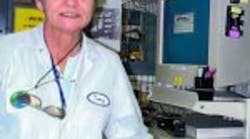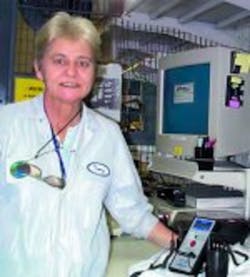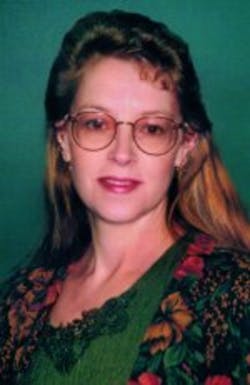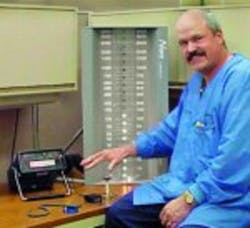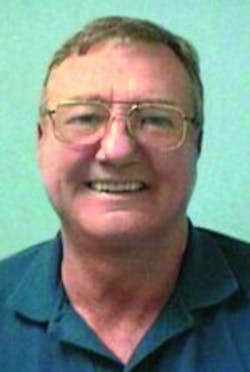If you are relatively new in the ESD control arena and could spend a few minutes with some specialists who have fought the static-control threat longer than you, what would you ask them? If you are an old-timer in ESD control, what experiences would you like to hear and compare with your own?
We sensed your curiosity, so we found six ESD practitioners who were willing to share their experiences. They come from different parts of the country, represent various types of products, and have an assortment of experiences. In the following paragraphs, you will meet:
- Phil Carey, the division ESD coordinator at Eastman Kodak in Rochester, NY.
- Cheryl Checketts, an ESD controller at Motorola in Mesa, AZ, where communications products are made.
- Tim Jarrett, the ESD program coordinator at Guidant, a medical devices manufacturer in St. Paul, MN.
- Duane Oglesby, a technical engineer IV at Planar Systems, Beaverton, OR, which is involved in producing military systems.
- Nancy Shuman, an ESD coordinator at Intel in Dupont, WA, the systems research and development group.
- Don Williams, the corporate ESD coordinator at Plexus, Neenah, WI, a contract manufacturer.
How They Entered the Battle
Each of these people recognized their employer’s need for an ESD specialist and responded enthusiastically. Sure, they knew that the assignment was an uncharted course, but in many ways, this enhanced their enthusiasm. There are common themes in their preparation—build a network, read, and join a local ESD Association chapter. No one tried it alone.
In 1986, Mr. Jarrett started in ESD control with a major computer manufacturer. The technology was relatively new at the company so his preparation was intense and diversified. He read all the available magazine articles, especially the “Coping With ESD” series in EE-Evaluation Engineering. Some good books also were very helpful.
Soon he was participating in the activities of the local chapter of the ESD Association. This gave him contacts and opened the door to some valuable benchmarking with other companies. With such preparation, he was ready for the greater responsibilities that greeted him at Guidant.
An ESD-control class taught by Bert Unger of Bert Unger Associates was the next step in her learning process. Soon she was sharing her own experiences with others. Now she is president of the local ESD Association chapter and attends the EOS/ESD Symposium every year. “There’s still a great deal to learn, and I want to keep working on it,” she said.
Mr. Carey was involved in contamination control when ESD control was integrated into his area of responsibility two years ago. He reports to the corporate ESD coordinator, and a large part of his training and networking has come through mentoring with Tom Albano.
ESD Program Definition
Mr. Jarrett was involved in the preparation and sign-off for ANSI/ESD S20.20-1999, The ESD Association Standard for the Development of an Electrostatic Discharge Program, and is extremely impressed with the work that so many put into it. Building on the technical content of the document, he developed a program at Guidant that mimics 20.20 fairly closely.
The ESD Association standards give many ESD specialists a good baseline for certifying equipment and materials. “We are deeply involved in government contracts, so the MIL Specs take precedence only until they are officially superceded by ESD Association documents,” Mr. Oglesby noted.
The ESD plan at Intel had evolved for many years before the 20.20 document came out, but Ms. Shuman noted that the company procedures are in almost total agreement. Mr. Williams found a plan in place when he came into ESD responsibility at Plexus, but he is in the process of transitioning to 20.20. “It is well thought out,” he said, “and I want to build our entire program on it.”
Training and Motivating Employees
Employee motivation at Intel is a struggle that Ms. Shuman constantly addresses. “I am winning the battle,” she reported. “If someone walks down the hall with an unprotected board, I intervene. Once I even stopped the president of the company, who very graciously apologized, thanked me for doing my job, and promised to be more attentive to ESD concerns in the future.”
She is responsible for ESD training at her site, and this gives her the chance to impart her keen awareness of the static threat to all employees. “I can teach the basic necessities,” she said, “but I still am not able to answer all the questions. I find the answers from others in the company or through the ESD Association. All of us learn as we move forward one step at a time.”
At Guidant, ESD training takes many forms. Each new employee who will have access to a clean room is given ESD training on a computer station, and everyone repeats this training once a year. Messages on a prominently located bulletin board in the dining room serve as a daily reminder of the potential dangers from ESD. Also, several times a year, ESD prevention is the topic of monthly engineering quizzes.
“The training job may be easier here than at other companies,” said Mr. Jarrett. “Every employee realizes that the pacemaker he or she is holding may go into Aunt Ellen’s or Uncle Bud’s chest.”
The operators at Planar Systems don’t have pacemakers to motivate them, but most employees abide by company regulations for ESD control. “I have the conformers preach to the reluctant ones,” Mr. Oglesby noted. “Peer pressure carries a great deal of weight. We have hands-on training, and displays on ESD topics seem to grab their attention.”
The Motorola ESD program has been in place so long that conformance is almost second nature for the employees, according to Ms. Checketts. “We periodically test people for their knowledge of and conformance to ESD control practices, and their job security is enhanced by this action. The people in each area police each other to uphold the reputation of their group. We don’t allow ESD control to be a mystery to anyone,” she continued.
At Eastman Kodak, new employees attend a two-hour certification class taught by the corporate ESD-control coordinator. Mr. Carey teaches the annual recertification classes.
At each Plexus facility, the entire manufacturing floor is an ESD-controlled area. “You don’t even enter the area until you are ESD-safe. We use movies to train and certify employees,” Mr. Williams reported. “We even rigged up a demo to show the effect of an ESD event, and employees are staggered by the potential damage that this silent stalker can cause.”
Unique Problems
Sure, every ESD control engineer has problems from time to time. For example, Mr. Jarrett found workers in the clean room using heel straps over their socks, a practice that was neither comfortable nor safe. He looked for booties, but couldn’t find any that were suitable. Instead, the company bought dissipative material and found a local garment manufacturer to listen to their needs, help with the design, and make booties to order.
“One of the frustrations at Motorola is finding ESD control products for the clean room that are really clean,” Ms. Checketts lamented. “We have to choose between compromising the clean room and compromising the static-control capability. We need a bigger and better selection of clean-room products.”
Temporary flooring material presents a constant problem at Guidant. Permanent floors work very well, but the company needs the same quality and shine in a floor that can be unrolled, used, and put back in storage.
With 2,000 to 3,000 workstations, ionizers are another matter of concern for Mr. Jarrett. “We have no problem with maintaining polarity balance. However, I wish we could find ionizers that are smaller and less expensive. We would like a wider area of coverage, too. I hope manufacturers can address all these factors,” he noted.
Audits
In addition to informal day-to-day inspections, the entire facility at Planar Systems is officially audited every quarter using a procedure developed by Mr. Oglesby after consulting with other members of the ESD Association. “The audit is never announced,” Mr. Oglesby commented. “It consists of our examination of conformance to procedures. We also ask our operators random questions about processes.”
Audits at Guidant are performed weekly to validate proper use of wrist straps and ionizers. Functions such as ionizer balance are audited on different schedules. Mr. Jarrett conducts some of the audits and delegates the others to a technician.
Ms. Shuman performs an unannounced ESD audit at least once a month. She would like to initiate some type of marker for each work area to show that the audit was performed, summarize the results, and serve as a constant reminder to help motivate workers.
Mr. Williams has counterparts in the various Plexus locations around the world. “Audits are done at every plant on a monthly basis, and I go to other plants for quarterly or annual audits,” he explained.
Eastman Kodak and Motorola have several audit levels, starting with frequent walk-throughs. Formal audits are performed quarterly.
The Role of the ESD Association
Without exception, these professionals appreciate the value of the ESD Association and its local chapters. They have benefited from its many opportunities for technical exchange and the standards that have been developed. In turn, several have contributed of their time and talents.
For example, Mr. Jarrett became active at the national level of the ESD Association. This started by attending the symposium and expanded as he began serving on committees. Today, he chairs the workstation standards subcommittee and sits on other committees.
In addition to being president of the local ESD Association chapter, Ms. Checketts serves on the national standards committees for wrist straps, hand tools, and workstations. She sees standards generation as an important aspect of the group and couldn’t do without the work of the standards committees.
However, she reminded us, “The ESD Association’s main charter is to educate. We see this aspect developing more every year. My associates and I have benefited from the training opportunities, will continue to take part in them, and highly recommend them to others.”
Mr. Oglesby is active in his local ESD Association chapter and has been asked to serve on the national standards committee. And Ms. Shuman also finds a great deal of mutual support at the local ESD Association meetings. Her only complaint: “Often, the program participants are pressed for time. As a result, new members have little opportunity for open discussion and a question-and-answer period to supplement the formal presentations.”
Advice to Others
How can a person who has just been given ESD control responsibilities come up to speed and stay that way? “Read as much as you can,” said Mr. Jarrett.
And both he and Ms. Checketts were adamant about the benefits of joining the local chapter of the ESD Association. By networking at both the local and national levels, you will tap into sources of good information, including solutions to many of your ESD-related problems.
Find a mentor, and use that source freely as you fight the inevitable problems. That advice comes from Ms. Shuman, who said, “My mentor has made my job much more meaningful than it might have been without that support. I don’t have a technical degree and need an engineer to rely on for in-depth technical backup.”
A warning comes from Mr. Oglesby: “Never—and I mean never—rely on a manufacturer’s specifications as the basis for certifying ESD material. Test each product with an approved standard. Also check for material-to-material tribocharging so you don’t get a surprise ESD event when equipment comes in contact with your product.”
Join—read—network. In these three words, Mr. Williams echoed the messages of his counterparts. They have all tried it, and it works.
Return to EE Home Page
Published by EE-Evaluation Engineering
All contents © 2000 Nelson Publishing Inc.
No reprint, distribution, or reuse in any medium is permitted
without the express written consent of the publisher.
June 2000
